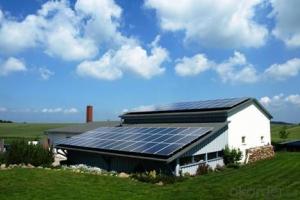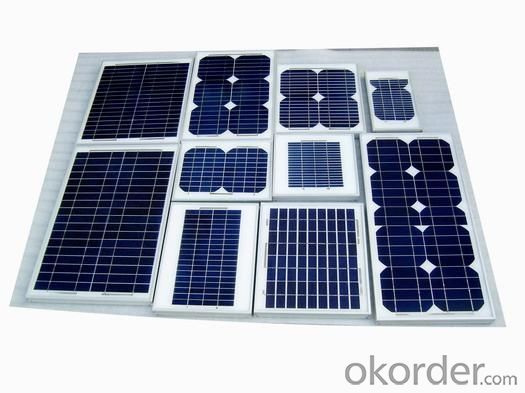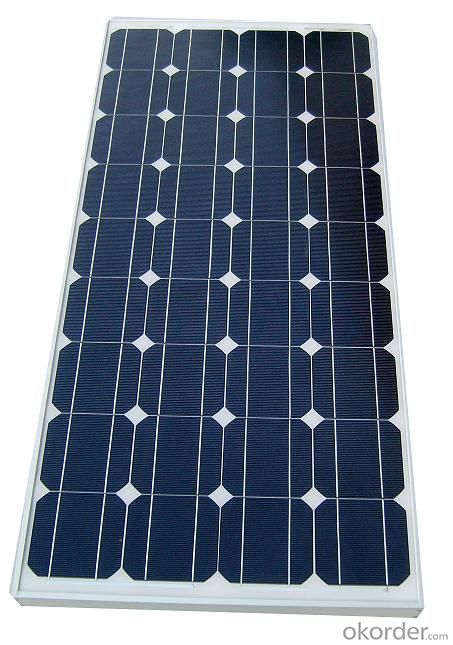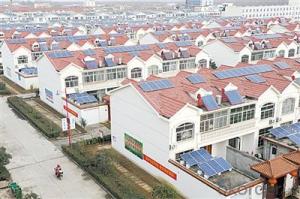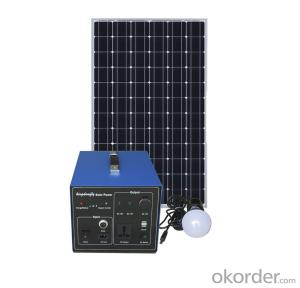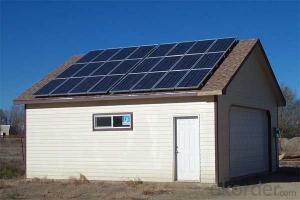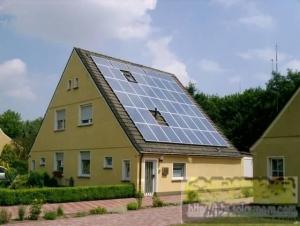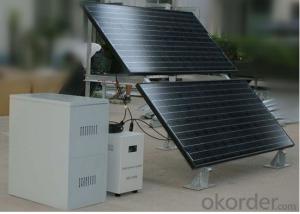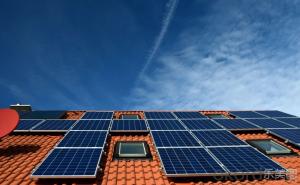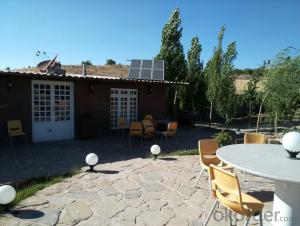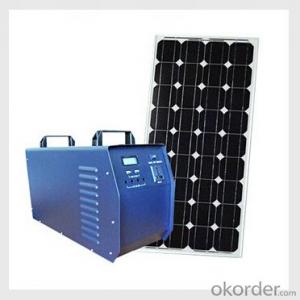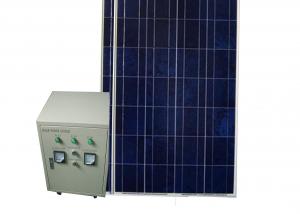Solar Energy Systems Oman:5kW Off-Grid System for Long Useful Time
- Loading Port:
- Shanghai
- Payment Terms:
- TT OR LC
- Min Order Qty:
- 20 set
- Supply Capability:
- 2000 set/month
OKorder Service Pledge
Quality Product, Order Online Tracking, Timely Delivery
OKorder Financial Service
Credit Rating, Credit Services, Credit Purchasing
You Might Also Like
Specification
Application:
Home
Output Voltage (V):
220
Solar System 5KW Made in China Off-Grid System
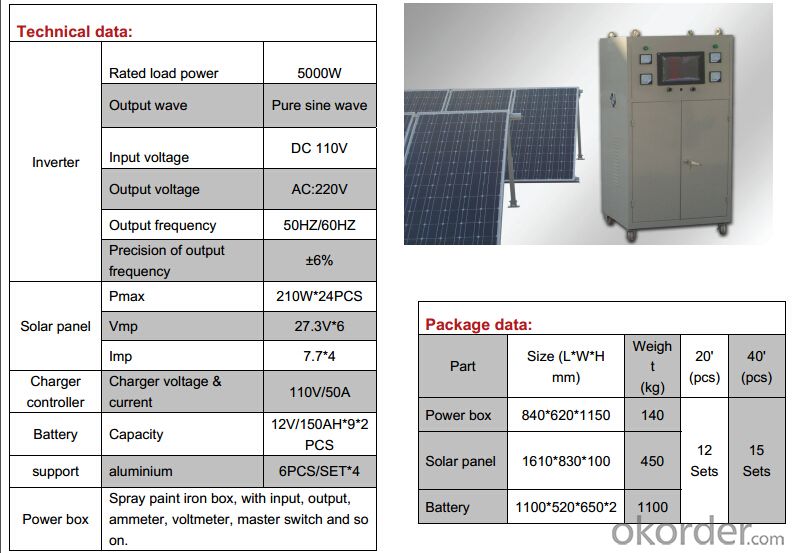
Solar system advantages:
1. CE, ROHS approved.
2. High conversion efficiency, high-transmission rate.
3. Energy saving, environmental-friendly.
4. Advanced technology, strict quality control system.
5. Easy installation, safe operation, free maintenance.
6. Low MOQ, fast delivery time, long service life.
System Device | |
| No | Device name |
| 1 | solar panels |
| 2 | inverter( off grid and on grid) |
| 3 | mounting system |
| 4 | combiner box |
| 5 | cable and other accessories |
| Quick Details | |||||
| Specification: | Mini | Application: | Home | Output Voltage (V): | 72V |
| Load Power (W): | 3.5-4.2KW | Solar Power (W): | 2KW | Work Time (h): | 4-5days |
| Packaging & Delivery | |
| Packaging Detail: | carton pallet |
| Delivery Detail: | within 7 days |
| Specifications | |||||
| 2KW Solar Power System | |||||
| Lifespan >20 years | |||||
| Designed to meet the needs for low power household appliances | |||||
| Base on your situaion ,we design the solar power system as following : | |||||
| 1: PV-system DC voltage level: DC 48V ,ouput AC voltage level: AC220V 50/60HZ | |||||
| 2: load Working time every day: 840W 5hours(3.5-4.2KW*h/day) | |||||
| 3: Primise rainy days: 2 days | |||||
| 4:PV system power Max Input Power: 2KW/DC72V Max AC Output Power: 2000W AC220V 50/60HZ,opration output power:inductive load <=1KW Resistive load:1.6KW | |||||
| 5: PV Array specification: Voc:DC86.4V Vmp:72V Isc:30A Imp:27.8A |
| Name | Type | Number | Remarks |
| MONO-Solar panel | JX200M/36V 1580*808*35mm | 10 | 2KW connection: 2 Series, 5 In parallel |
| Battery | 12V200Ah | 8 | Gel batteries The total capacity:DC48V/400Ah |
| PV-inverter | JX-2KW | 1 | inputDC48V -outputAC220V 50/60HZ,city power automatic switch |
| PV support | JX-S200-10 | 1 | 10 Pcs solar panels use a PV support , Material: Hot -dip galvanized |
| Battery box | JX-C24 | 1 | size:780*800*900mm 4layerdetachable type |
| PV Controller | CM4860 | 1 | DC48V 60A , RS485 communication function |
| PV cable,connect bettwen | PV-1*4.0mm2 | 100 | PV -specific single-core copper 4.0 mm2 cable,Double protection cover 100M |
| Power cable | BVV-1*16mm2 | 50 | single-core copper 16 mm2 cable,Double protection cover |
- Q: How do solar energy systems impact energy education and awareness?
- Solar energy systems have a significant impact on energy education and awareness by providing a tangible and visible demonstration of the potential of renewable energy. They serve as practical examples that help individuals understand the benefits and capabilities of solar power, ultimately leading to increased awareness and knowledge about sustainable energy sources.
- Q: How do solar energy systems contribute to reducing carbon emissions?
- Solar energy systems play a crucial role in the reduction of carbon emissions through various means. Firstly, solar energy, being a renewable and eco-friendly power source, helps tackle this issue. By utilizing solar panels that convert sunlight into electricity without emitting any greenhouse gases, solar energy eliminates the release of carbon dioxide and other harmful pollutants into the atmosphere, a stark contrast to traditional fossil fuel power plants. Secondly, solar energy has the potential to replace the usage of fossil fuels in multiple sectors. For instance, residential rooftops can be fitted with solar panels to generate electricity for homes, reducing the dependence on coal or natural gas for power generation. Similarly, solar farms can be established to produce large-scale solar power for commercial and industrial purposes. By substituting fossil fuels, solar energy systems contribute to the reduction of carbon emissions associated with electricity generation. Furthermore, solar energy can also be utilized for heating purposes. Solar thermal systems can capture the sun's heat and provide hot water for residential and commercial buildings. By incorporating solar thermal systems, the demand for gas or electricity to heat water diminishes, resulting in a decrease in carbon emissions during the water heating process. Moreover, the widespread adoption of solar energy systems can lead to an overall decrease in the demand for fossil fuels. As more households, businesses, and industries transition to solar power, the need for coal, oil, and natural gas diminishes. Consequently, this reduced demand for fossil fuels can drive down their production and consumption, resulting in a significant reduction in carbon emissions associated with their extraction, refining, and combustion. In conclusion, solar energy systems contribute to the reduction of carbon emissions by producing clean and renewable electricity, replacing fossil fuels, reducing the demand for traditional energy sources, and providing an alternative for heating purposes. By embracing solar power, we can make substantial progress in combating climate change and strive towards a sustainable future.
- Q: Are there any risks of electromagnetic radiation with solar energy systems?
- Yes, there are potential risks of electromagnetic radiation associated with solar energy systems. Solar energy systems use photovoltaic (PV) panels to convert sunlight into electricity. These panels generate direct current (DC) electricity, which is then converted into alternating current (AC) electricity for use in our homes and businesses. One potential source of electromagnetic radiation is the inverter, which is responsible for converting DC electricity into AC electricity. In some cases, these inverters can produce electromagnetic fields (EMFs) that may emit low-frequency radiation. While these EMFs are generally considered to be low and within acceptable limits, there is ongoing research to better understand any potential health effects associated with long-term exposure to these fields. Another potential risk is the presence of high-frequency electromagnetic radiation from radio frequency (RF) communication devices, such as wireless monitoring systems or communication modules used in solar energy systems. These devices transmit and receive signals wirelessly, and there is some concern about the potential health effects of long-term exposure to RF radiation. However, the power levels of these devices are generally low, and they are designed to comply with safety standards and regulations. It is important to note that the risks associated with electromagnetic radiation from solar energy systems are generally considered to be low compared to other sources of electromagnetic radiation in our everyday lives, such as cell phones, Wi-Fi routers, or power lines. Nonetheless, it is always recommended to follow safety guidelines provided by manufacturers and industry standards to minimize any potential risks.
- Q: What is the environmental impact of solar energy systems?
- Solar energy systems have a significantly lower environmental impact compared to conventional energy sources. With no greenhouse gas emissions during operation, solar power helps reduce carbon dioxide and other harmful pollutants that contribute to climate change. Although the manufacturing process does require energy and materials, the long-term benefits of solar energy in reducing emissions and dependence on fossil fuels far outweigh its initial environmental costs. Furthermore, the land used for solar installations can often be dual-purposed, such as for agriculture or wildlife conservation, minimizing any ecological disruption. Overall, solar energy systems play a crucial role in mitigating environmental degradation and transitioning towards a cleaner, more sustainable energy future.
- Q: Can solar energy systems be used in areas with limited access to healthcare facilities?
- Yes, solar energy systems can be used in areas with limited access to healthcare facilities. Solar energy can power medical equipment, refrigeration systems for vaccines and medicines, and lighting in healthcare facilities, allowing them to function even in remote areas without reliable access to electricity. This can greatly improve healthcare services and enable the delivery of essential medical care, diagnostics, and treatments in underserved communities.
- Q: How much sunlight do solar panels need to generate electricity?
- Solar panels need direct sunlight for at least 5-6 hours per day to generate a significant amount of electricity.
- Q: Can solar energy systems be used for powering electric vehicle solar charging garages?
- Yes, solar energy systems can be used to power electric vehicle solar charging garages. Solar panels can be installed on the roofs or surrounding areas of the garages to generate electricity from sunlight. This renewable energy can then be utilized to charge electric vehicles, reducing the dependence on fossil fuels and decreasing carbon emissions.
- Q: Can solar energy systems be used for powering remote communication towers?
- Yes, solar energy systems can be used for powering remote communication towers. Solar panels can be installed on or near the towers to capture sunlight and convert it into electricity. This renewable energy source can provide a reliable and sustainable power supply for remote communication towers, reducing the need for traditional grid-based electricity or diesel generators. Additionally, solar energy systems can be easily integrated with battery storage to ensure continuous power availability, even during periods of low sunlight or at night.
- Q: Can solar energy systems be used for powering off-grid eco-villages?
- Yes, solar energy systems can certainly be used to power off-grid eco-villages. Solar panels can generate electricity from the sun's energy, which can then be stored in batteries for later use. This renewable and clean source of energy is ideal for eco-villages that prioritize sustainability and reducing their carbon footprint. With advancements in technology, solar energy systems have become more efficient and affordable, making them a viable option for powering off-grid communities.
- Q: Can solar energy systems be used in agricultural settings?
- Solar energy systems are certainly applicable in agricultural settings. The utilization of solar energy in agriculture has gained popularity in recent years. The installation of solar panels on rooftops or as ground-mounted systems in agricultural fields is a means to generate clean and renewable electricity. There are multiple ways to implement solar energy in agricultural settings. One prevalent application is the use of solar power for irrigation systems. Solar-powered water pumps effectively draw water from wells or other sources and distribute it for irrigation purposes. This reduces reliance on fossil fuel-powered pumps and lowers overall energy costs for farmers. In addition, solar energy can be employed to power electric fences, lighting systems, and ventilation systems in livestock operations. These systems contribute to improving animal welfare, boosting productivity, and reducing the environmental impact associated with traditional energy sources. Furthermore, solar energy can facilitate crop drying and processing. Solar dryers remove moisture from crops, minimizing the risk of spoilage and prolonging shelf life. Solar-powered processing equipment, such as grain mills and oil presses, enhance the efficiency and sustainability of agricultural practices. Moreover, solar energy systems offer a dependable source of electricity for remote agricultural areas without access to the grid. This enables farmers to acquire modern technologies, improve productivity, and increase income. Overall, integrating solar energy systems into agricultural settings offers numerous benefits. It reduces greenhouse gas emissions, decreases reliance on fossil fuels, lowers energy costs, improves efficiency, and enhances the sustainability of agricultural practices. Therefore, solar energy presents a viable and promising option for powering various agricultural activities.
Send your message to us
Solar Energy Systems Oman:5kW Off-Grid System for Long Useful Time
- Loading Port:
- Shanghai
- Payment Terms:
- TT OR LC
- Min Order Qty:
- 20 set
- Supply Capability:
- 2000 set/month
OKorder Service Pledge
Quality Product, Order Online Tracking, Timely Delivery
OKorder Financial Service
Credit Rating, Credit Services, Credit Purchasing
Similar products
Hot products
Hot Searches
Related keywords
